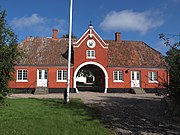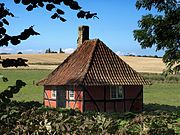Hagenskov
Hagenskov (formerly Frederiksgave) is an estate in the Syddanmark region on the island of Fyn in Denmark.
Preserved structures
The manor house is located in the southeast of the complex. It is a two-story classical plastered building with a central projection from the 1770s. The eleven-axis building is covered by a hipped roof. Opposite - separated from the manor by a public thoroughfare - are the former farm buildings of the estate, which are arranged in a horseshoe shape around a large inner courtyard.
Previous construction
Hagenskov was originally a four-winged, two-storey medieval castle complex that was approximately 100 m long and 70 m wide. The castle was on a hill a few hundred meters southeast of today's manor complex. Hagenskov was considered one of the safest castles in Denmark. The possessions included over 8,000 hectares of land and 220 farm sites.
history
Hagenskov was first mentioned in 1251 when King Abel issued an order exempting the citizens of Faaborg from customs duties.
In 1259 , after a feud, King Kristoffer I kidnapped Archbishop Jacob Erlandsen and locked him in Hagenskow's dungeon.
In 1396 Queen Margrethe managed to buy Hagenskov back from the Holstein counts, and after that the estate remained in the possession of the Danish crown for almost 300 years.
Frederik III. , Denmark's first absolute monarch, bequeathed Hagenskov to one of his loyal followers, Niels Ottesen Banner. As a token of his gratitude, Banner asked the king for permission to rename the estate Frederiksgave . It carried this name until 1962.
In 1741 the old medieval castle burned down to the ground. After the merchant Niels Ryberg had acquired the property, he built today's mansion in the classical style a few hundred meters from the old castle in the 1770s. The architect was GE Rosenberg. The old castle hill was cleared, partially removed and converted into a terrace-shaped pleasure garden. It is open to the public today. Niels Ryberg was considered to be socially committed, he was one of the first landowners to give the farmers freedom. He founded the first obstetrics practice and was involved in education and church affairs. After Ryberg's death in 1804, his son took over the estate.
In 1813 , however, after the landlord went bankrupt, it became state property. A number of changing owners followed: in
1854 , after an auction, the estate was taken over by the Weddelsborg estate.
In 1942 it was bought by the wine merchant and consul Thor Andersen.
In 1954 it went to Preben Caroc Claus Schall Holberg. This achieved that the mansion was registered as a national monument from 1962 and the property was allowed to use the old name Hagenskow again.
In 2009 Jacob Caroc Claus Schall Holberg became the owner of Hagenskov.
Literature (in Danish)
- Preben Caroc Schall Holberg: Ey blot til lyst, livets theater.
- Jørgen Hansen: Hagenskov's history.
Web links
Coordinates: 55 ° 13 ′ 39 ″ N , 9 ° 59 ′ 15 ″ E






